An ANNIVERSARY RETROSPECTIVE — CRISIS TURNS 40!
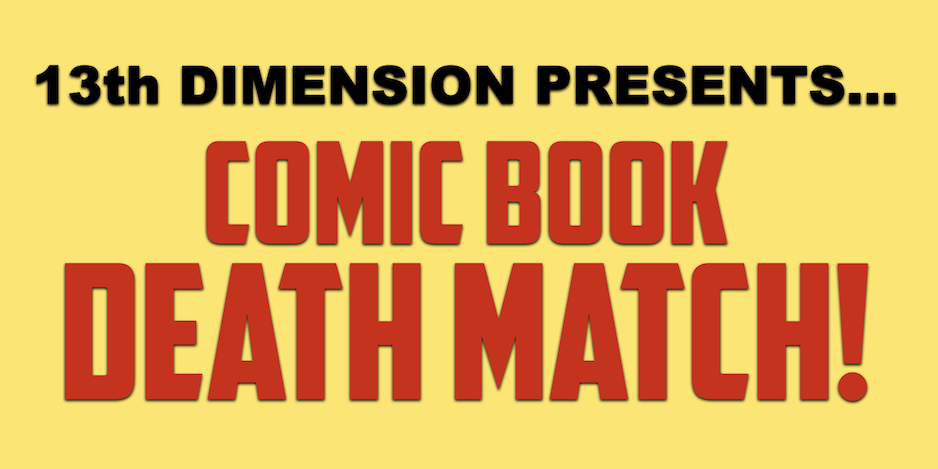
Hey, guess what: Today (Jan. 3, 2025) is the kinda-sorta 40th anniversary of DC’s Crisis on Infinite Earths, by Marv Wolfman and George Perez. Issue #1 hit comics shops at the end of 1984, but landed on newsstands Jan. 3, 1985. Fred Van Lente spent the last year writing a monthly COMIC BOOK DEATH MATCH column comparing — insightfully and hilariously — Crisis and Marvel’s original Secret Wars, issue by issue. Here’s the coda to his grand adventure. — Dan
—
By FRED VAN LENTE
Fans love complaining about big comics events, like they love to complain about variant covers, but, like variant covers, they keep buying big event comics, so publishers are going to keep making them.
The true progenitor of all modern comics events is Marv Wolfman and George Perez’s Crisis on Infinite Earths, which I just spent the last year pitting against Marvel Super Heroes Secret Wars in my COMIC BOOK DEATH MATCH column. Though Secret Wars came out first, Marvel elected to do this weird thing where regular titles’ continuity was interrupted only for a brief hiccup when heroes got spirited away to Battleworld in one month, and then the very next month they just as mysteriously returned. The events of the Secret Wars series continued for the rest of the year in between those two bookends.
In fact, there were so few official Secret Wars tie-ins that when I did the equivalent of this column for it a year ago, I had to hedge the headline to say “The Top 13 Ways Secret Wars Changed the Marvel Universe,” to meet this site’s quota of 13 entries!
With Crisis, however, no such rhetorical chicanery is required: According to the category for the event on the DC Universe app, there are no less than (gulp!) one-hundred and seven Crisis-related titles (including the main series). And having now read all of them, I can tell you that number feels low.
We have Crisis to thank/blame for the cover bannering and every-title-must-participate mandate of current comics events. Here are the 13 highlights of what was at the time a grand experiment: Can an entire line of comics all tell the same story? Let’s see:
—
13. Infinity, Inc. #19: “Last Crisis on Earth-Two!” You’d think that if anybody would be upset about the multiversal annihilation of Crisis it’d be Roy Thomas, Mr. Leave-No-Golden-Age-Character-Behind himself. But to his credit, he took it all in stride: If anything, he saw it as an opportunity to cram even more superheroes into the pages of his two Earth-2 titles, this and All-Star Squadron.
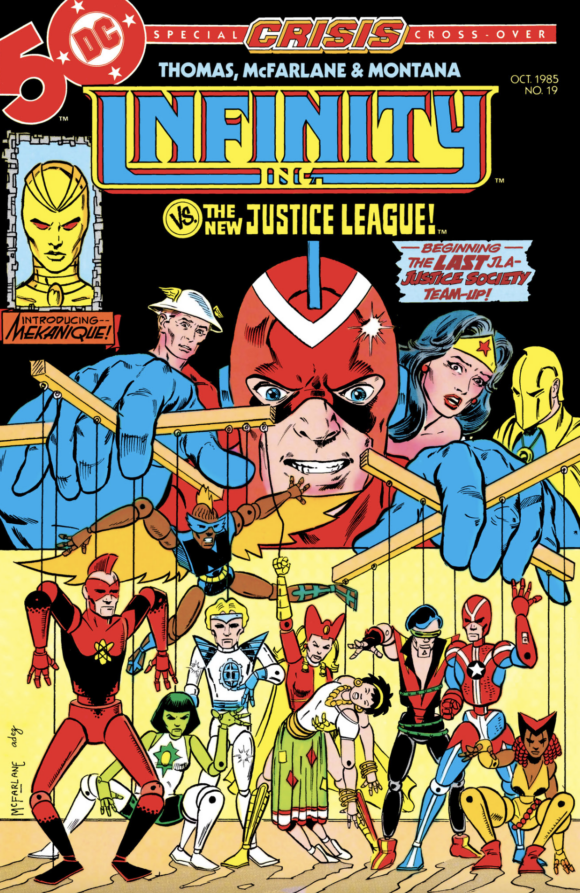
Of course, he also gets the chance to do the last-ever (allegedly, at the time) crossover between the Justice Society and Justice League here. For DC fans I assume this was like the Summer Olympics, if the Summer Olympics happened every year. Fittingly, because the current Justice League is a bunch of back-benchers led by the Martian Manhunter out of Detroit for some reason, this JLA doesn’t fight the actual JSA but their kids, the titular Infinity, Inc.
Their throwdown is contrived by Commander Steel, who is the WWII-era grandfather of JL-Detroit’s rank-less Steel. The old Steel hates the young Steel for stealing (get it) his thunder or something something? They didn’t really sell me on the conflict here. Regardless, the real star is young Todd McFarlane, whose innovative layouts offer early insight into a style that would soon take the industry by storm.
—
12. Batman #390: “Women Dark and Dangerous.” The Dark Knight was too cool for school to have the Crisis bannering on the covers of his title or Detective Comics. It’s probably just as well, because the only real connection to the maxiseries is that the skies of Gotham City are red and rainy (but then, it seems like it’s always raining in Gotham).
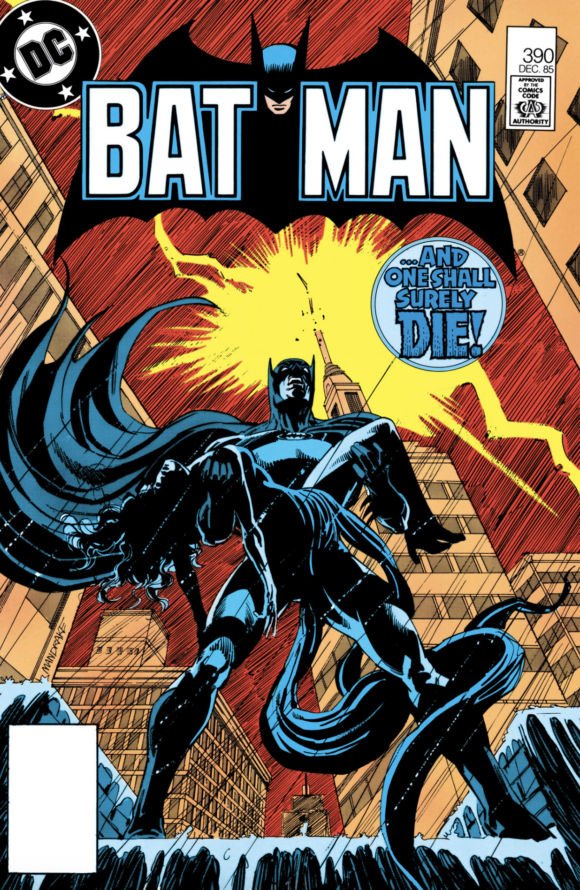
Center stage here is Bruce Wayne’s totally dysfunctional love life, as he’s caught between frequent squeeze Catwoman and Nocturna, a melanin-challenged thief who also might be Jason (Robin) Todd’s mother. (I’m a little unclear on whether or not that was resolved.) Vicki Vale and Alfred’s daughter Julia are also around to pine for and/or be pined after by Bats. At a certain point, even James Bond would be like, “Dude, make up your mind, already.”
Ultimately, Catwoman and Nocturna have a fun fight in the latter’s abandoned lighthouse hideout, which is why I put it on this list. Tom Mandrake’s cover does a clever job obscuring who’s the winner of that one. Writing is by poached Moon Knight scribe Doug Moench and the great interiors are by Mandrake too.
—
11. Legion of Super-Heroes #18: “Has Anyone Noticed a Crisis Going On?” A solid entry in the popular run of writer Paul Levitz, joined here by artists Greg LaRocque and Larry Mahlsedt. As the title suggests, the Legion grapples with the gaps in their memory between noticing the changes that Crisis has wrought in their future timeline and not actually remembering the Crisis itself. While investigating the origins of the problem (clearly they learned nothing from Krona’s example), they accidentally unleash an old transdimensional enemy, the Infinite Man.
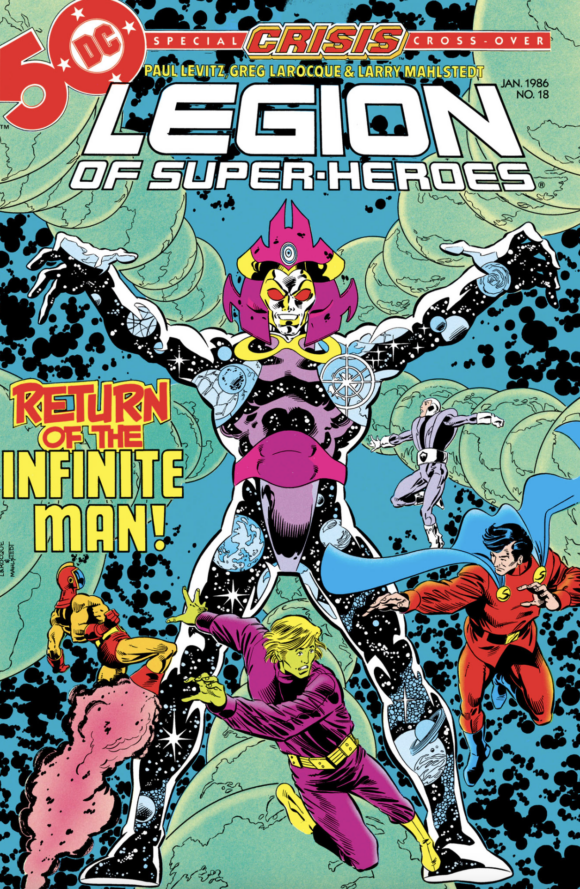
—
10. DC Comics Presents #86: “Into the Valley of the Shadow…!” 13th Dimension’s own Celebrated Mr. K, Paul Kupperberg, makes the list with this fun tale of the Kryptonian Cousins brought to life by Rick Hoberg on pencils. Kara gets a nice final adventure on the same newsstand-month that she shuffles off this mortal coil by tangling with an enemy reawakened by the cosmic shenanigans of Crisis. Blackstarr is Supergirl’s landlady’s daughter and a concentration camp survivor who went crazy when cracking Einstein’s Unified Field Theory gave her absolute control over all aspects of the cosmos. I hate it when that happens! Supergirl is lucky she died, because otherwise she would’ve had to move.
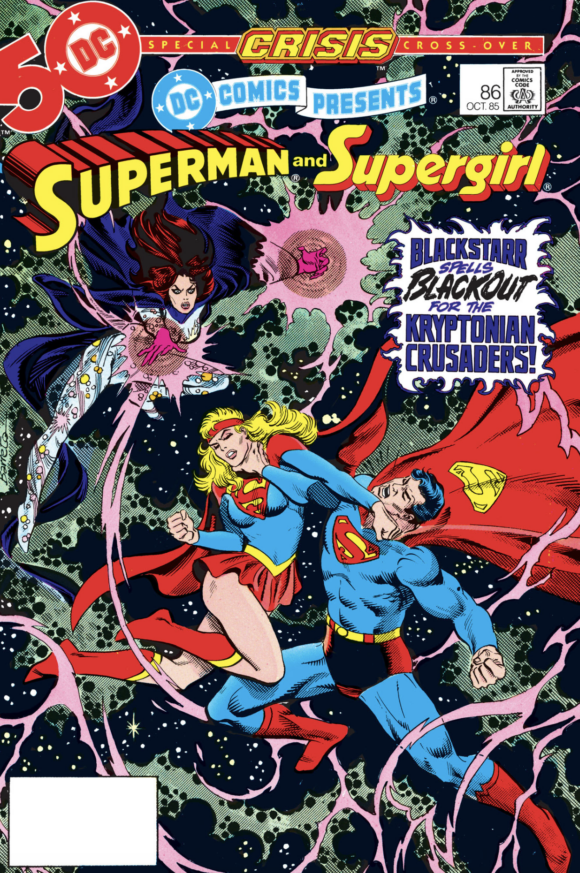
—
9. The Fury of Firestorm #42: “A Long Night’s Journey into Day.” A little over two miles from where I’m typing this is the Fulton Ferry Landing, where the most important moment in American history you’ve never heard of happened: After thoroughly crushing the Continental Army in invading Brooklyn by way of Staten Island, Sir William Howe chose not to pursue and destroy George Washington’s retreating troops. He might have thought heavy rain and fog would prevent Washington from ferrying his entire army across the East River to Manhattan Island and (relative) safety.
Quite the opposite turned out to be true; the weather concealed Washington’s miraculous evacuation. Had Howe decided to take the initiative to crush the rebellion then and there, you and I would now be Canadian, saddled with the metric system and adding extra u’s into every word. We’d even have the government underwriting our comics conventions! Oh, the horror!!
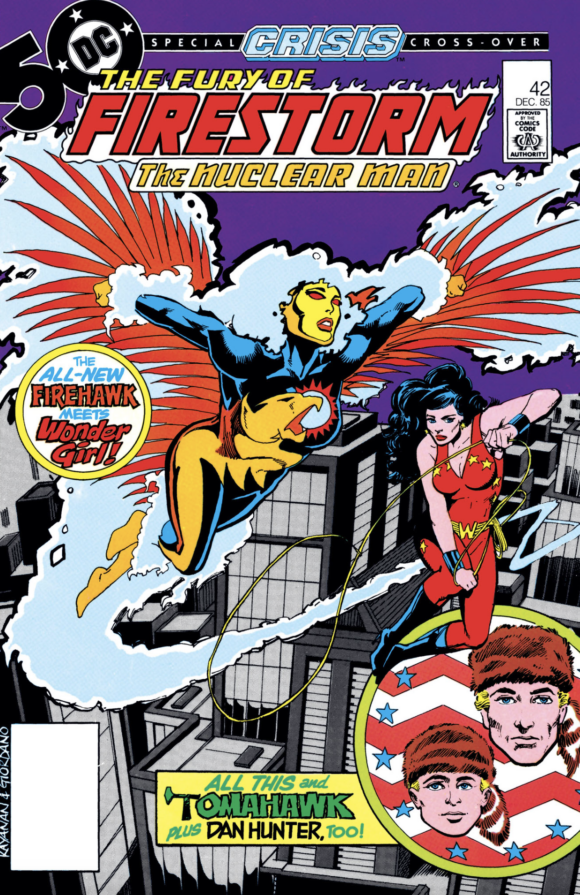
And to think that all this time I thought it was Howe’s hesitation that was the deciding factor here. But this comic by Gerry Conway and Rafael Kayanan makes it clear that it was actually Firehawk and Wonder Girl running interference for Washington while looking for Firehawk’s dad and Wonder Girl’s husband in a time-mashed New York that allowed the Americans to escape. Oh, and Tomahawk was there too. Who says comics aren’t educational?!
—
8. All-Star Squadron #51: “Monster Society of Evil!” This comic book by Danette & Roy Thomas and Arvell Jones & Mike Clark is completely bananas and I love it. The new Monster Society of Evil moves into the Justice Society’s HQ after many All-Stars have been zapped away by Harbinger to the Monitor’s space station. Once the Society subdues Dr. Fate and Hourman, Earth-S’s own Mr. Mind explains why he has come to Earth-Two, which is because he has become obsessed with the comedy stylings of one Charlie McCarthy via inter-dimensional radio.
Hitching a ride on Harbinger, somehow, Mr. Mind goes to McCarthy’s mansion, only to discover, to his horror, that his idol Charlie is a wooden dummy manipulated by ventriloquist Edgar Bergen. Though how exactly a ventriloquist act is impressive over the radio I’ll never understand. You and I can be ventriloquists over the radio!
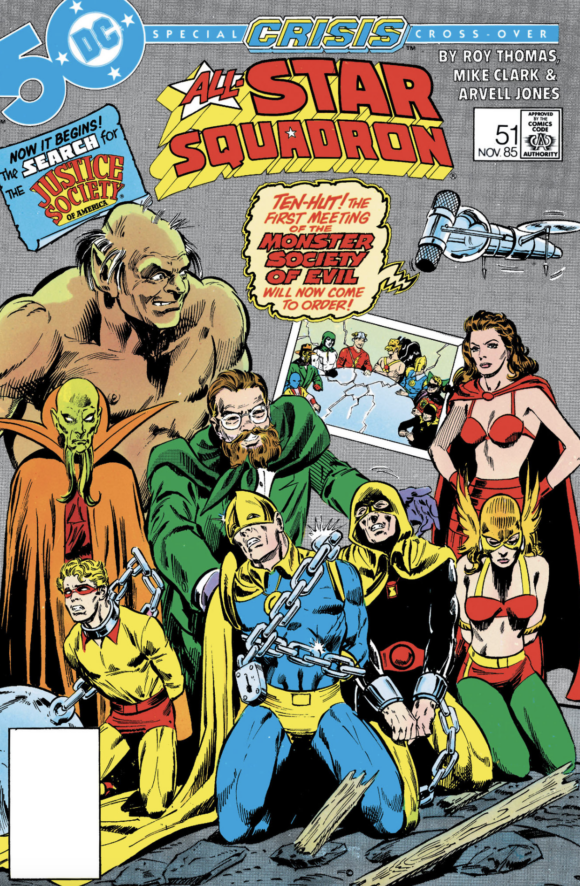
Being an insane talking mad-scientist worm, of course Mr. Mind doesn’t work out his disappointment in a positive way; no, instead, he breaks into the JSA’s headquarters and goes through their records to find a bunch of obscure Golden Age villains to wreak havoc. (Only Roy Thomas would have the balls to add an asterisk note directing readers to All-Star Comics #3 (1940) or its 1975 reprint to know who the heck the giant villain Oom is. Those comic books are 45 and 10 years older than this one—anyone who could run to their long boxes to check those issues out would be entering college by 1985.)
—
7. Blue Devil #18: “The Last Parallel World Story.” This is a super-fun done-in-one that actually uses the unique situation of Crisis to tell a unique story: The Earth-One Dan Cassidy, a stuntman who has been fused with his costume to become an actual Blue Devil, runs smack dab into his own interdimensional counterpart and his supporting cast, who hail from a bizarre timeline where an entire intergalactic empire is run by Hollywood. When the natives of the two different timelines start getting trapped in each other’s dimensions, they need the help of some stray members of the Omega Men to set the situation right. Great use of “integrating” a line-wide event into your own series by regular writers Gary Cohn and Dan Mishkin, with fantastic pencils by our own Paul Kupperberg’s brother Alan.
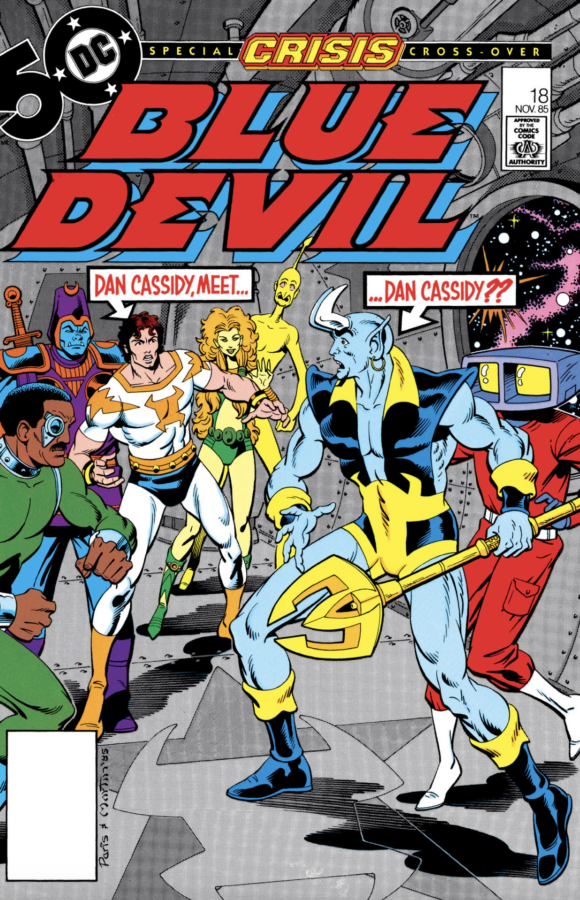
—
6. Justice League of America #245: “The Long Road Home” Like the previous entry, this one takes advantage of the multiversal melding of Crisis to do something different. Writer Gerry Conway has fun with timeline mash-ups in his Firestorm entry; here he sends the aforementioned Steel to a bizarre post-apocalyptic Earth ably brought to life by Suicide Squad MVP Luke McDonnell. We are now (Dr. Evil finger) one billion years in the future, where one-time JLA bad guy Lord of Time is at war with his own clones, and Steel decides to help. I mean, who wouldn’t trust that face?
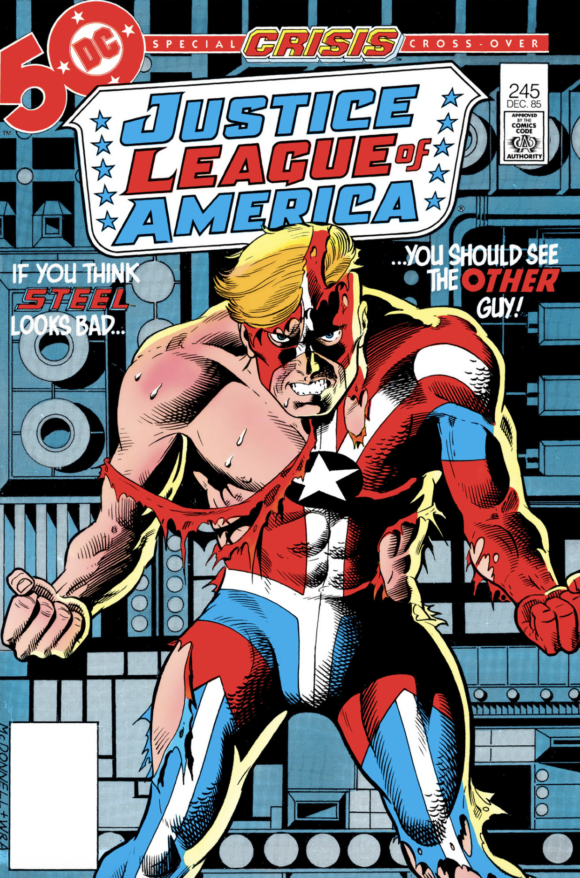
—
5-4. DC Comics Presents #87 (“The Year of the Comet” + “The Origin of Superboy-Prime!”) and Superman #414 (“Revenge Is Life—Death to Superman!”) I will confess to not being very familiar with the work of Eliot S! Maggin (I presume the “!” is silent), probably because I’ve never been the biggest Superman fan. He imbues the Crisis and its effects on Superman in the wake of Supergirl’s death with a graceful poetry that challenges the Alan Moore entry on this list as the best written (“If a history of this time were ever to be written—such a history as can never be told—it would tell of great signs in the skies… of the Earth’s gravity altered wildly, moment to moment, under a sky turned the color of war…”). Maggin treats Superman’s mythology with a mysticism and complexity like something out of the Hindu Veda.
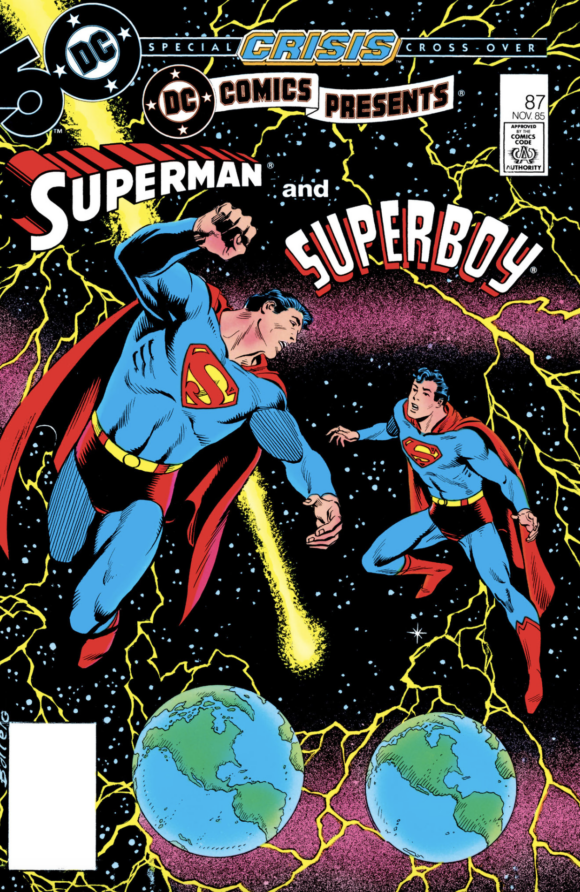
I will try to summarize this two-parter as best I can without sounding like a babbling maniac: Aliens in the Superman Revenge Squad exploit his grief over Supergirl’s death to zap him with a ray that catapults him into another world, which…I think?…is our world, where he is a well-known fictional hero. This act, along with the arrival of Halley’s Comet (again: I think), grants a boy whose name is “Clark Kent” his own powers.
As it turns out though, this Kent really is Kal-El from another of the Infinite Kryptons, where Jor-El sent his infinite son to safety via interdimensional teleportation rather than a My First Rocket, and he winds up on our world. He teams up with his Earth-One counterpart to defeat the Revenge Squad on his home Krypton.
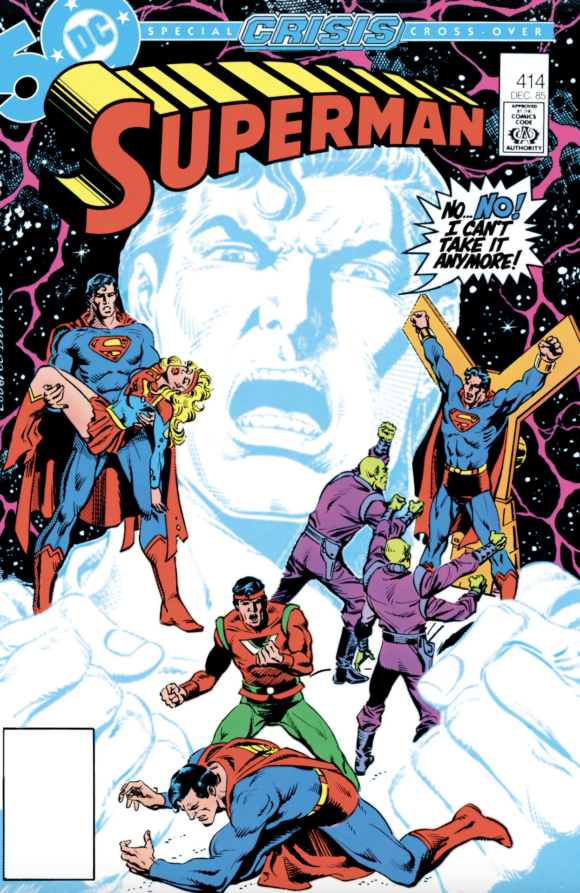
This is an oddly touching story, even for someone, like me, who does not have a PhD in Superology; the relationship between the two Clarks, the latter of whom is paradoxically a fanboy of the former, is the high point. Penciller Curt Swan effortlessly brings to life gorgeous sequences like the surreal bit where the Clarks communicate in space by ripping off bits of Halley’s Comet and spelling out messages to each other.
—
3. Swamp Thing #46: “Revelations.” Alan Moore, Stephen Bissette and John Totleben do a great job of plopping Crisis seamlessly into the middle of their epic “American Gothic” storyline that has John Constantine prepping Swampy for a coming (and utterly unrelated) cosmic apocalypse. There’s a bit of irony that future ’90s edgelord “Hellblazer’s” first appearance is inexorably connected to the painfully mainstream Crisis—take that, Vertigo!—but that’s neither here nor there.
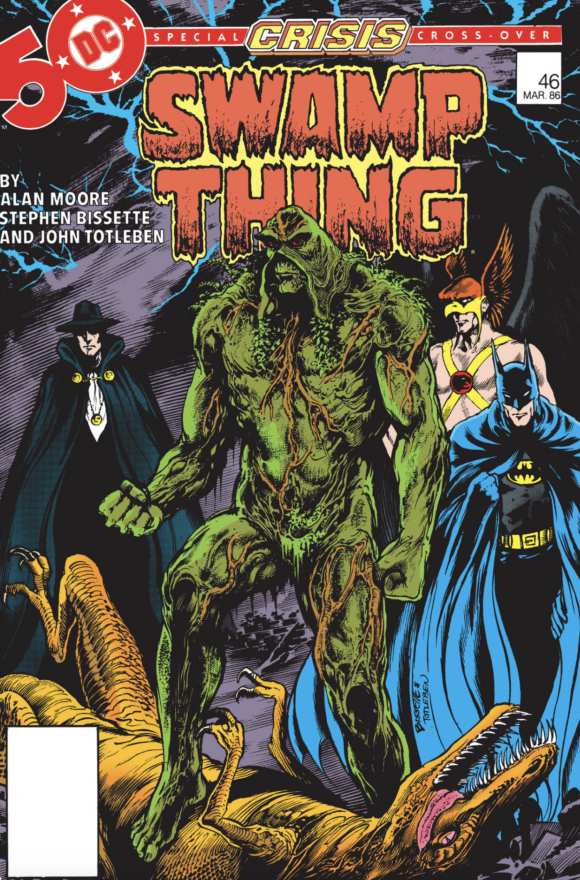
1985’s No. 1 Sting Impersonator takes Swamp Thing on a teleportation tour of various Crisis-affected hotspots, including the Monitor’s space station, and the visuals are as trippy as one might expect from this creative team handed this kind of storytelling opportunity: “At the end of the world, the horrors and marvels could not be counted.” My favorite is the woman in the fur stole menaced by the stoat-people in the alley who I bet got zapped in from Kamandi’s time.
It’s also worth noting that the ending sequence, in which one of Constantine’s allies is taken out by a horrific minion of the apocalypse cult, is one of the single scariest things I’ve ever seen in a comic book….
—
2. Green Lantern #198: “1” (and also “0”). I often forget that my favorite DC Comics of the 1980s—the aforementioned Suicide Squad, the “bwha-ha-ha” Justice League era, the O’Neil-Cowan Question—came not out of Crisis, but Legends, the John Ostrander-plotted event that followed it.
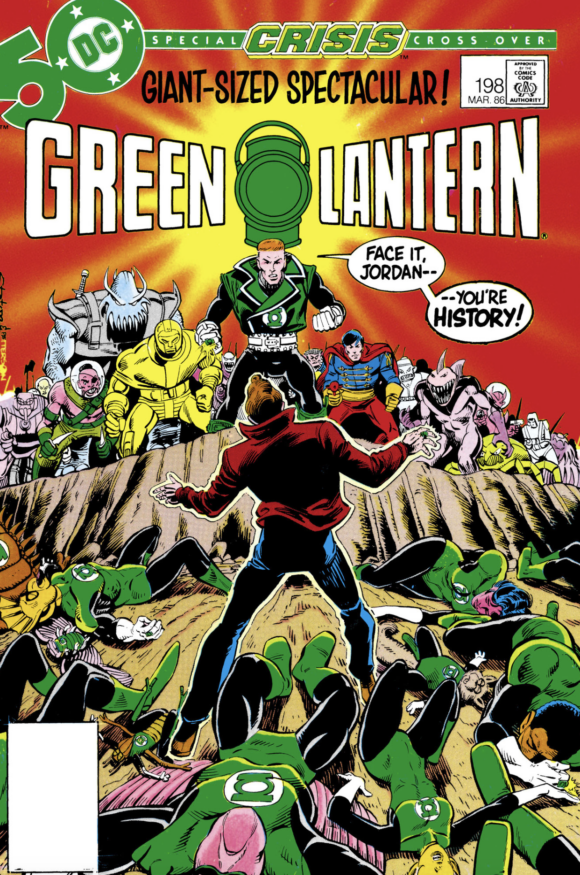
However, this tie-in mega-read made me realize that the “Guy Gardner as Toxic Masculinity with a Bowl-Cut” Green Lantern that many viewers of the James Gunn Superman trailer have discovered for the first time came from this storyline by Steve Englehart and (mostly) the amazing Joe Staton, a massive epic that has its double-size climax here. Two opposing forces of Green Lanterns and GL villains, led by John Stewart on one side and Gardner on the other, try to destroy or defend the Anti-Monitor’s birthplace of Qward in the anti-matter universe, with ex- but soon to be ex-ex-Green Lantern Hal Jordan caught in the middle. It’s one of the few double-size climaxes worthy of the name, with a final space battle to make Lucasfilm green with envy (see what I did there).
—
1. Wonder Woman #329: “Of Gods and Men.” In speaking of “worthy double-size climaxes,” the final issue of this long-running title gives its heroine a fantastic send-off, courtesy of Gerry Conway and Don Heck. Though Alan Moore and Curt Swan’s “Whatever Happened to the Man of Tomorrow?” is a justly revered farewell to the Man of Steel before John Byrne’s reboot, this story—billed as “A Final Adventure of Wonder Woman”—does an equally great job of prepping everyone’s favorite Amazon for the George Perez-led revamp to follow.
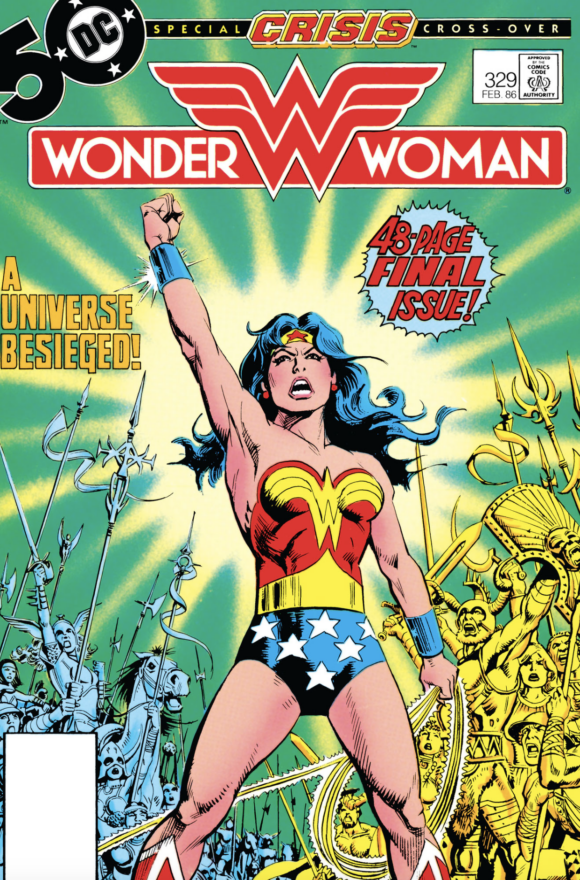
On the eve of a climactic battle with Ares, Princess Diana finally asks Steve Trevor to marry her, then charges to Paradise Island to battle a horde of resurrected Olympian warriors thanks to the God of War’s new ally, Hades. Guess who wins? And Zeus performs the marriage of Diana and Steve. I’m not crying, you’re crying!
—
MORE
— SECRET WARS: The TOP 13 Ways It Changed the MARVEL UNIVERSE — and Didn’t. Click here.
— The Complete COMIC BOOK DEATH MATCH Index. Click here.
—
13th Dimension contributor Fred Van Lente is an award-winning, New York Times-bestselling comics writer, as well as an occasional novelist, teacher, and playwright. Sign up for updates on his upcoming projects and check out the trailer for his comics-writing course at his web site, fredvanlente.com.

January 3, 2025
Eliot S! Maggin is easily one of the top three Superman writers ever and his novel “Last Son of Krypton” was a precursor to what Moore and Morrison did with the character. He was even the first writer to have Lex Luthor as a rich businessman, but with a clever twist.
January 6, 2025
I just reread The Last Son of Krypton (after about 44 years since I last read it – my copy is looking a bit brown) and remains one of the greatest Superman stories ever. The little bits about Superman and Luthor’s lives could have whole story arcs made out of them. Utterly brilliant
January 24, 2025
I agree. It was the first novelization of a superhero I’d ever read. I thought I’d miss the storyboard art but the complexity of the prose unhindered by the limitations of narration boxes and word balloons quickly transported me to a richer Metropolis and deeper dive into what really makes Lex hate Supes so much.
January 3, 2025
>>… they keep buying big event comics…
>>>
For me, Crisis was the start of the end. Many of my favorite heroes were being changed in ways undesired or just done away with completely (Flash, GL). The “darkness” to come (TDKR) and even more multi-part stories would be the final straw. (Looking at you New 52.)
January 3, 2025
Thee aforementioned sequence in Swamp Thing #46 is truly one of the most scary comic book scenes for me as well. Bruce Chatwin (“In Patagonia”) should get a shout out as well…
January 3, 2025
Okay, that was suprisingly fun. Thank you for this.
The Englehart/Staton Green Lantern run up to this point is one of the high points both of Englehart’s career and of Hal Jordan’s long history and is easily the most *coherent* take on the CRISIS overall. For some reason, Tomar-Re’s ring declaring it belongs to John Stewart makes me a bit weepy even now, 40 years later.
And I was one of the people who would have the Treasury-sized reprint of ALL-STAR COMICS in 1984. Got it when it was new and read it over and over!
January 4, 2025
I have this theory that some of the Crisis crossovers were intended to boost the sales of series that were not selling as well. I know there were exceptions, but there were a number of crossovers in which fleeting references were made to the Crisis. I believe it’s supported by the fact that, following Crisis, some of the series underwent major revamps or changes in approach, Superman, Wonder Woman, All-Star Squadron, Firestorm and Green Lantern being prime examples. I know it was inevitable that All-Star Squadron (one of my favorites at the time, by the way) would be affected by the Crisis, but I wonder if the powers that be wanted to ensure fans didn’t write off the series as one that would end once Crisis was done and drop it in advance. Roy Thomas has said he wasn’t told the Earth-2 Superman, Wonder Woman and Batman would be phased out and that’s why he created stand-ins for the Young All-Stars series. And it’s natural that Green Lantern would be affected by the Crisis, but it also was revamped, as a team book (when team books were selling well) after the Crisis. I don’t recall there being many Crisis crossovers with Batman, which usually seems to be a good seller. It’s great that some creators tried to have some fun with it, though.